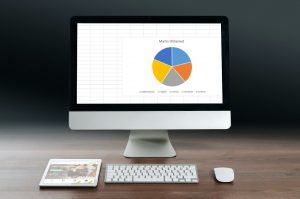Picture this: You are making a sales dashboard to be presented to the upper management of the company. During the presentation, your CFO asks you to pick out the raw data from a particular chart. At that moment, you cannot go back to the underlying database and give him the exact figures, can you? Nor can you afford to waste screen estate on dashboards by displaying tables right below the charts. So what now? Bring in FusionCharts v3.1’s option to export the data from your chart in CSV with a single click in the context menu — and your problems are solved.
So let’s say this is one of the charts you have in your sales dashboard:

Table of Contents
How to export chart data?
The chart data can be exported to CSV in two ways:- Using the right-click menu of the chart, which copies the generated CSV data to clipboard.
- Using FusionCharts JavaScript API for data export, which returns the CSV data as string in your JavaScript code
Exporting data from right-click menu
If you want to enable exporting of data using the right-click menu for your end user, it is as simple as this:
showExportDataMenuItem attribute of the <chart> element as 1.
Exporting chart data using Javascript API
You can access the data of the chart from its JavaScript API as well. To know more about the Javascript APIs exposed by FusionCharts, please visit the section ‘FusionCharts and Javascript’ section in our Online Documentation. Exporting chart data using Javascript API is a 2-step process: 1.Set theregisterWithJS flag of chart as 1 in your HTML code.
2.Invoke the getDataAsCSV() API only after the chart has been rendered (i.e., in FC_Rendered method)
If we did the above and put the data in an alert box as soon as the chart was loaded, this is what our output would look like:

Displaying exported data (using Javascript API) in an alert box
Yes, it is more like a “Hello World” example but then you get the point, don’t you? To see the exact code going behind the above example and more customization options, please check out the documentation on this here.Don’t like the CSV output?
If you don’t like comma as the data separator and double-quotes as the data qualifier in your CSV output, you can customize them to your liking. This is done using theexportDataSeparator and exportDataQualifier attributes respectively.
If you want your CSV output to look a little cryptic for some purpose, here is something you can do:
The CSV output would now look like this:
<span>ySalespersonyxxySales Figurey</span> <span>yAlexyxxy25000y</span> <span>yMarkyxxy35000y</span> <span>yDavidyxxy42300y</span> <span>yGrahamyxxy35300y</span> <span>yJohnyxxy31300y</span>
Formatted CSV Output
FusionCharts smartly formats all the numbers in your chart using the number suffix/prefix as defined by you and using K(Thousands) and M(Millions) for large numbers. If you wish to export the chart data with all the number formatting in place rather than the raw numbers themselves, set theexportDataFormattedVal attribute of the <chart> element to ‘1’ – it is turned off by default.
Once you have done that, the formatted CSV output would look as under:
“Salesperson”,”Sales Figure”
“Alex”,”$25K”
“Mark”,”$35K”
“David”,”$42.3K”
“Graham”,”$35.3K”
“John”,”$31.3K”
That’s all about exporting data as CSV using FusionCharts. As always, we covered the feature here for FusionCharts specifically but it applies equally well to the other products in the FusionCharts Suite – FusionMaps, FusionWidgets and PowerCharts as well.
Next up in the “How to get the most out of v3.1?” series is the usage of vertical separator lines for easier comprehension of data in the chart. So stay tuned…


